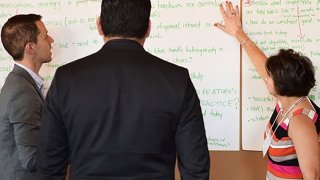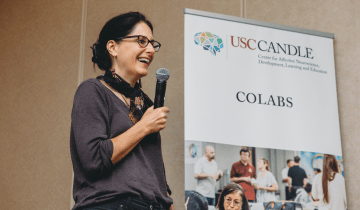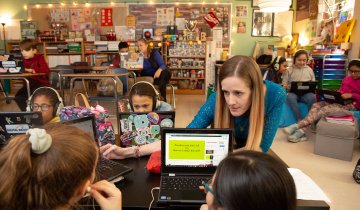For two days, some of the country’s top math education researchers gathered at USC Rossier to plan ways to improve elementary math education across the country.
Brought together by the Joan Herman and Richard Rasiej Mathematics Initiative, 50 professors, researchers and scholars discussed on Monday and Tuesday what the field of math education research does and doesn’t know—and what can be done to fill in the gaps.
“What we’re hoping to do is take advantage of the fact that we have people in the room coming at this problem from a variety of perspectives,” said Rasiej as the event kicked off, noting the different research backgrounds of those attending. "We have people who don’t always talk to each other. I’m hoping we can find ways for establishing a baseline of what we have learned."
The mathematics initiative began in fall 2016 following a $1 million gift from Herman and Rasiej, and seeks to improve mathematics knowledge and teaching of current teachers in elementary school classrooms. A nine-person group that includes USC Rossier faculty, postdocs, PhD students, staff and Rasiej is leading the initiative; the project is funded for five years.
(See all the members of USC Rossier leading the math initiative.)
The known and unknown
Over the past several decades, researchers have put forth a wealth of material about math education, but those studies have not always translated to practice, and at times have come into conflict with each other.
To address such issues, symposium attendees worked in small groups to answer three main questions: What do we know? What do we need to know? What do we do about it?
Groups tackled each problem from different lenses, including learning, teaching and policy and measurement, bringing into that work their backgrounds from varied fields, including education policy, learning science, teacher education and education psychology.
As the symposium wore on, attendees grappled with what should be done both as a field and as a symposium group. Had they properly considered research around teacher longevity? How would their answers have changed if most attendees were math teachers instead of researchers? How should they interact with think tanks, or policymakers, or press?
“It was exciting to see this initial outcome of the mathematics initiative, and to have experts come together to make an impact on elementary mathematics teaching and learning,” said Professor of Psychology and Education Gale Sinatra, who is one of the initiative leaders.
Attendees used the second day of the symposium to figure out concrete action steps, with the ultimate goal not only being to improve research but also to, eventually, influence policy. Some groups chose to focus on communication efforts within the research community, while others focused on communication with policymakers and educators, and still others explored how to improve the usefulness of research.
“It was very gratifying to see a group of thought leaders come together with a real commitment to producing meaningful and lasting improvements in the quality of mathematics instruction in the elementary grades,” Rasiej said after the symposium. “I believe everyone felt a sense of moral urgency about the need to provide excellent math instruction to all students.”




